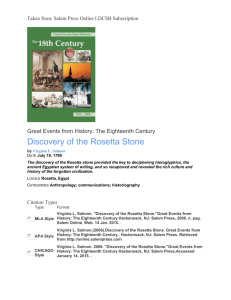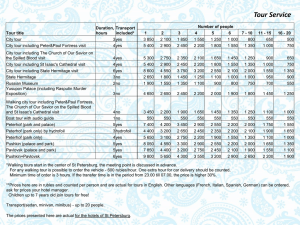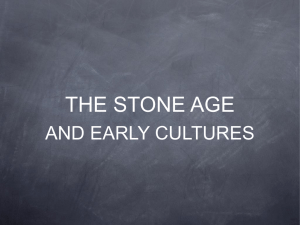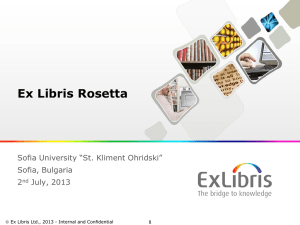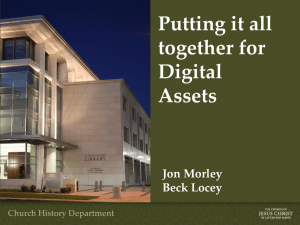Rosetta Stone - WordPress.com
advertisement
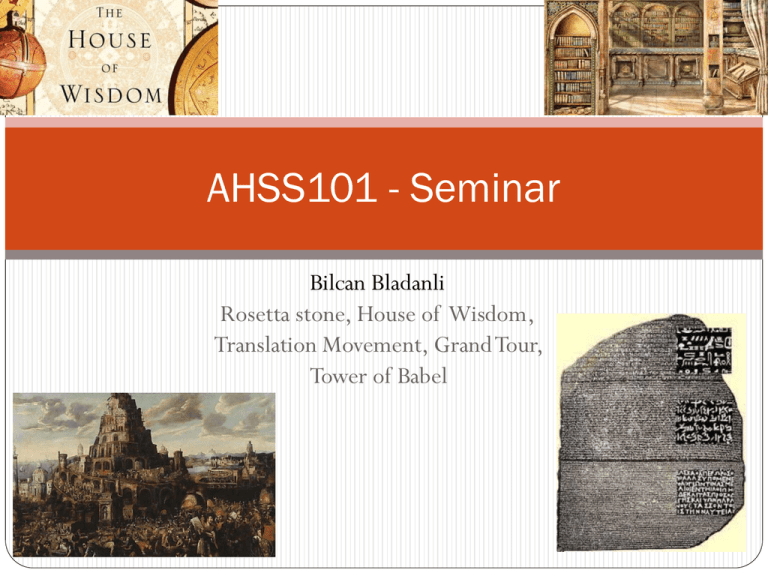
AHSS101 - Seminar Bilcan Bladanli Rosetta stone, House of Wisdom, Translation Movement, Grand Tour, Tower of Babel Rosetta Stone The Rosetta Stone is a stone with writing on it in two languages (Egyptian and Greek) using three scripts (hieroglyphic, demotic and Greek) carved in 196 B.C. It is written in three scripts because when it was written, there were three scripts being used in Egypt. So that the priests, government officials and rulers of Egypt could read what it said. The first was hieroglyphic which was the script used for important or religious documents. The second was demotic which was the common script of Egypt. The third was Greek which was the language of the rulers of Egypt at that time. ... Although it is believed to have originally been displayed within a temple, the stone was probably moved during the early Christian or medieval period and used as building material in the construction near the town of Rashid (Rosetta) in the Nile Delta. And discovered there in 1799 by French soldiers, during their Napoleonic expedition to Egypt. It is called the Rosetta Stone because it was discovered in a town called Rosetta (Rashid). What does the Rosetta Stone say? The Rosetta Stone is a text written by a group of priests in Egypt to honour the Egyptian pharaoh. It lists all of the things that the pharaoh has done that are good for the priests and the people of Egypt. ... Many people worked on deciphering hieroglyphs over several hundred years. However, the structure of the script was very difficult to work out. After many years of studying the Rosetta Stone and other examples of ancient Egyptian writing, Jean-François Champollion deciphered hieroglyphs in 1822. it was the essential key to modern understanding of Ancient Egyptian literature and civilization. It’s translation provided the key to the modern understanding of Egyptian hieroglyphs. The term Rosetta Stone is now used in other contexts as the name for the essential clue to a new field of knowledge. The House of Wisdom Baghdad The House of Wisdom (Bayt al-Hikma) was a major intellectual centre during the Islamic Golden Age. The House of Wisdom was founded by Caliph Harun al-Rashid and culminated under his son al-Ma'mun who is credited with its formal institution. Based in Baghdad from the 9th to 13th centuries Al-Ma'mun is also credited with bringing many well-known scholars scholars including those of Persian or Christian background to share information, ideas, and culture in the House of Wisdom. These scholars were paid handsomely for teaching and translating texts into Arabic. Also caliph Al Ma'mun paid some of the best translators a books equivalent weight in gold. Al Ma'mun sent representatives to the libraries of Constantinople and Sicily to borrow or copy their books to add to the library in the House of Wisdom. Besides translating books into Arabic and preserving them, scholars associated with the House of Wisdom also made many remarkable original contributions to diverse fields. During the reign of al-Ma‘mun, astronomical observatories were set up, and the House was an unrivalled centre for the study of humanities and for science in medieval Islam, including; mathematics, astronomy, medicine, alchemy and chemistry, zoology, geography and cartography. Drawing on Indian, Greek, and Persian texts, the scholars accumulated a great collection of world knowledge, and built on it through their own discoveries. By the middle of the ninth century, the House of Wisdom was the largest repository of books in the world. TRANSLATION MOVEMENT One night in Baghdad, the 9th century Caliph Al-Ma’mun was visited by a dream. The philosopher Aristotle appeared to him, saying that the reason of the Greeks and the revelation of Islam were not opposed. On waking, the Caliph demanded that all of Aristotle’s works be translated into Arabic, and they were. Over the next 300 years (about 800 A.D. to 1150 A.D.) major works in philosophy, medicine, engineering and mathematics in Greek, Syrian and other languages were translated into Arabic. This attempt became known as the “translation movement” It’s led by a limitless excitement to import knowledge from across the world, and it was a movement of extraordinary depth and scope, and according to many scholars, awakened the European Renaissance, and future generations. TOWER OF BABEL The Tower of Babel is a story told in the Book of Genesis (also referred to as the Hebrew Bible) meant to explain the origin of different languages. The story of the city of Babel is recorded in Genesis . Everyone on earth spoke the same language. As people migrated from the east, they settled in the land of Shinar. Engraving The Confusion of Tongues by Gustave Doré (1865) People there sought to make bricks and build a city and a tower with its top in the sky, to make a name for themselves, so that they not be scattered over the world. Then God came down and confounded their speech, so that they could not understand each other, and scattered them over the face of the earth, and they stopped building the city. Thus the city was called Babel. The 1st-century Jewish interpretation explains the construction of the tower as a hubristic act of defiance against God ordered by the arrogant tyrant Nimrod. But The Bible does not specifically mention that Nimrod ordered the building of the tower. As the King James version of the Bible puts it: 4 And they said, “Come, let us build ourselves a city, and a tower whose top is in the heavens; let us make a name for ourselves, lest we be scattered abroad over the face of the whole earth.” 5 But the Lord came down to see the city and the tower which the sons of men had built. 6 And the Lord said, “Indeed the people are one and they all have one language, and this is what they begin to do; now nothing that they propose to do will be withheld from them. 7 Come, let Us go down and there confuse their language, that they may not understand one another’s speech.” 8 So the Lord scattered them abroad from there over the face of all the earth, and they ceased building the city. 9 Therefore its name is called Babel, because there the Lord confused the language of all the earth; and from there the Lord scattered them abroad over the face of all the earth. —Genesis 11:4–9 The Grand Tour The Grand Tour was the traditional trip of Europe undertaken by mainly young English elites of the seventeenth and eighteenth centuries often spent two to four years travelling around Europe in an effort to broaden their horizons and learn about language, architecture, geography, and culture in an experience known as the Grand Tour. The Grand Tour began in the sixteenth century and gained popularity during the eighteenth century. The term Grand Tour was introduced by Richard Lassels in his 1670 book Voyage to Italy. And Samuel Johnson observed in 1776 that “A man who has not been in Italy, is always conscious of an inferiority from his not having seen what is expected a man should see” The idea was for wealth young travellers to finish their education with an extensive trip to Europe to experience its natural beauties, its cultural treasures. The Grand Tourists were primarily interested in visiting those cities that were considered the major centres of culture at the time - Paris, Rome, and Venice were not to be missed. But the destination par excellence was Italy with its Renaissance glories and classical Splendours. Upon their return to England, Tourists were supposedly ready to being the responsibilities of an aristocrat. The Grand Tour as an institution was ultimately worthwhile for the Tour has been given credit for an dramatic improvement in British architecture and culture. The French Revolution in 1789 marked the end of the Grand Tour for in the early nineteenth century.
